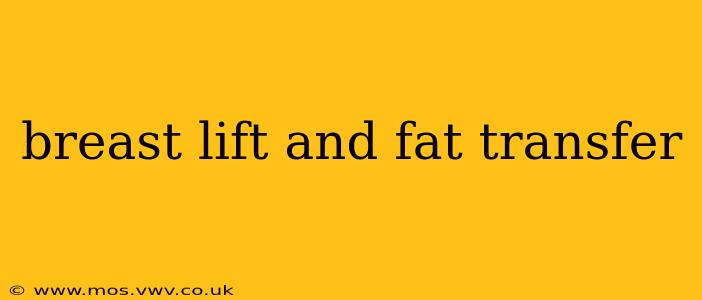A breast lift, or mastopexy, and fat transfer are two increasingly popular procedures used to enhance breast appearance. While often considered separately, they can be effectively combined for optimal results. This comprehensive guide will explore each procedure individually, delve into the combined approach, address common questions, and help you make an informed decision.
What is a Breast Lift?
A breast lift is a surgical procedure designed to improve breast shape and position. Gravity, pregnancy, breastfeeding, and significant weight fluctuations can cause breasts to sag, resulting in a loss of volume and fullness. A breast lift addresses this by removing excess skin and repositioning breast tissue to create a more lifted, youthful appearance. The incision technique varies depending on the degree of lift needed, and your surgeon will discuss the best option for your individual anatomy and desired outcome.
What is a Fat Transfer to the Breasts?
Fat grafting, or autologous fat transfer, involves harvesting fat from one area of the body (typically the abdomen, thighs, or hips) and transferring it to the breasts. This process not only adds volume but also enhances the natural shape and contour of the breasts. The transferred fat cells are carefully processed before injection to maximize survival rates. The result is a more natural-looking breast augmentation compared to traditional implants.
Combining Breast Lift and Fat Transfer: Synergistic Benefits
Combining a breast lift with a fat transfer offers several advantages:
- Natural Enhancement: Fat transfer creates a more natural-looking breast augmentation, avoiding the artificial appearance sometimes associated with implants.
- Improved Shape and Contour: The lift addresses sagging, while the fat transfer restores volume and fullness, resulting in a balanced, aesthetically pleasing shape.
- Reduced Scarring: While scars are unavoidable with a breast lift, the combined procedure often requires smaller incisions than a lift alone, potentially minimizing scarring.
- Minimally Invasive: Compared to implant surgery, the combined procedure often requires a shorter recovery period.
How is the Procedure Performed?
The procedure typically begins with liposuction to harvest fat from a donor site. This fat is then processed to remove impurities and excess fluid. Simultaneously, the breast lift is performed, repositioning breast tissue and removing excess skin. Finally, the purified fat is carefully injected into the breasts to achieve the desired volume and shape.
What is the Recovery Process Like?
Recovery time varies depending on the extent of the procedures and individual healing rates. Expect some discomfort, swelling, and bruising in the initial days following surgery. A supportive bra will be required for several weeks. Your surgeon will provide specific post-operative instructions, including pain management and activity limitations. Full recovery may take several months.
How long does the fat last in breast augmentation using fat transfer?
A significant portion of the transferred fat will be absorbed by the body over time. However, a substantial amount typically remains, providing long-lasting volume enhancement. The percentage of fat that survives varies between individuals, and ongoing maintenance procedures might be necessary.
Does fat transfer increase breast size?
Yes, fat transfer can increase breast size, but the amount of volume enhancement depends on the amount of harvestable fat and the individual's anatomy. It's a more gradual approach to breast augmentation compared to implants.
Is it possible to combine breast lift and breast implants?
Yes, a breast lift can be combined with breast implants, although this is a different procedure than combining a breast lift with a fat transfer. The choice depends on individual preferences and goals, factors such as breast size, and the surgeon's recommendation.
What are the risks associated with breast lift and fat transfer?
As with any surgical procedure, there are potential risks, including infection, bleeding, hematoma formation, seroma (fluid collection), and changes in breast sensation. Your surgeon will discuss these risks in detail during your consultation.
Conclusion:
Choosing between a breast lift, fat transfer, or a combination of both requires careful consideration and a thorough consultation with a qualified plastic surgeon. This guide provides a general overview, but individual needs and preferences vary. A personalized assessment will help you determine the best approach to achieve your desired aesthetic goals. Remember to research your surgeon thoroughly and choose someone with extensive experience in these procedures.
